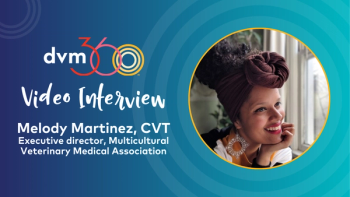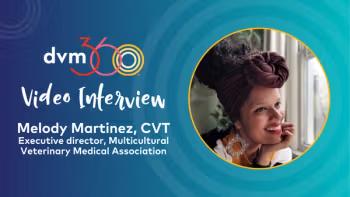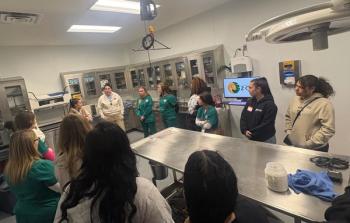
Tighten your dentistry knowledge (Proceedings)
There are three common head shapes in the dog and cat.
Skeletal anatomy
Skull types
There are 3 common head shapes in the dog and cat.
Mesocephalic or mesaticephalic - the most common head shape. Cephalic means head. Meso or mesati means medium. Typical mesocephalics are poodles, corgis, Labrador retrievers, and domestic shorthair cats.
Brachycephalic - brachy means short. Brachycephalic animals have a short and wide skull. This commonly results in crowded and rotated premolars. Typical brachycephalic animals are boxers, pugs, bulldogs, and Persian cats.
Dolichocephalic - dolicho means long and straight. These animals have long, narrow heads with an extremely long and thin mandible. Typical dolichocephalic animals are greyhounds, borzois, and sealpoint Siamese cats.
Maxillary
Incisive Bone: The rostral part of the maxilla. Within the body of the incisive bone are the six incisor teeth and the oval palatine fissures.
Dorsal aspect
Nasal aperture: This is composed of 2 symmetrical halves separated by the nasal septum
Ventral aspect
Incisivomaxillary suture: This articulates the incisive bone with the maxilla .
Incisive foramen : This is the opening to the incisivomaxillary canal
Maxillary Bone: The main body of the maxilla. Within the body of the maxilla are the premolars and molars.
Dorsal aspect
Infraorbital foramen: The most prominent feature of the dorsal maxilla. It is the opening to the cranial end of the infraorbital canal through which passes the infraorbital nerve, artery and vein.
Maxillary foramen: Opening to the caudal end of the infraorbital canal.
Pterygopalatine fossa : this is where the pterygoid and the palatine bones meet. Located in the rostral part of this fossa are two foramina.
Sphenopalatine foramen: This opens into the sphenopalatine canal which carrys the caudal nerves and vessels to the nasal cavity
Caudal palatine foramen: This is located ventral to the sphenopalatine foramen. This opens into the palatine canal which carries the anterior and posterior nerves and vessels to the hard and soft palate
Alveolar bone: This is the bone in which the tooth roots sit.
Alveolar jugae: The bony prominences on the buccal wall the alveolar bone
Ventral aspect
Palatine suture: midline of the hard palate
Palatine sulcus: These are the bony troughs that sit on either side of the palatine suture. The major palatine nerves and vessels pass along this sulcus to supply the tissues of the hard palate
Major palatine foramen: This is located palatal to the upper fourth premolar
Minor palatine foramen: This is located palatal to the upper first molar
Interradicular septa: This is the bone that separates the roots of an individual tooth
Interalveolar septa: This is the bone that lies between teeth
Mandibular: The lower teeth are embedded in the mandible. The mandible is made up of symmetrical bilateral bones. The areas of the mandible are divided into three areas – the symphyseal, the body and the ramus.
Symphyseal Region: This contains the incisors and canine teeth
Mandibular symphysis: The strong fibrous joint that fuses the two bones of the mandible at the rostral aspect
Anterior mental foramen: These are located just below and between the first and second incisor.
The Body of the Mandible: This contains the premolars and molars.
Middle and posterior mental foramina: These are located on the buccal aspect of the mandible apical to the second premolar and third premolar respectively. The mental nerves run through the anterior, middle and posterior mental foramina innervating the lower lip and chin.
The Ramus of the Mandible is the perpendicular portion of the bone.
Masseteric fossa: This is located on the buccal aspect of the ramus. It is a depression which serves as a point of insertion for the masseter muscle.
Mandibular foramen: This is located on the lingual aspect of the ramus. The inferior alveolar nerve passes through this foramen into the mandibular canal and innervates the mandibular teeth.
Anatomy of the periodontium
Attached gingiva: This is the gum tissue that is attached to the outer layer or periosteum of the alveolar bone.
Marginal or Free gingiva: Coronal to the attached gingiva at the cemento-enamel junction.
Gingival Sulcus: The space between the tooth and the free gingiva
Mucogingival Line (MGL): The line that separates the attached gingiva from the free gingiva.
Dentition and tooth classifications
Heterodont - teeth of mixed form and function
Diphyodont - having a set of primary (deciduous) teeth and secondary (permanent) teeth
Anelodont - having a limited period of growth as they develop roots
Brachyodont - having a root that is longer than the crown
Hypsodont - having a long crown and a short root, much of the crown is held in reserve subgingivally in the alveolar bone.
Elodont - teeth that grow throughout life and never develop roots
Dogs and Cats - Heterodont, diphyodont dentition with anelodont, brachyodont teeth
Horses - Heterodont, diphyodont dentition with anelodont, hypsodont teeth
Rabbits - Heterodont, diphyodont dentition with elodont teeth, the deciduous teeth are not functional and are exfoliated shortly before or after birth
Dental anatomy
Tooth anatomy
Crown: That part of the tooth that is visible above the gumline
Enamel: The outermost layer of the crown. It is the hardest body substance. It prevents the tooth from being invaded by bacteria and acids. Is not a living substance, so if damaged it will not regrow.
Dentin: Layer under the enamel. It is less calcified than enamel. It is continuously secreted by the odontoblasts which are located on the dentinal side of the pulp chamber. It has a porous structure made up of tubules which run from the pulpal tissue to the cementodentinal junction.
Root: The tooth structure below the gumline.
Cementum: Layer of bony tissue which covers the root
Periodontal Ligament: Attaches to the cementum on one side of the tooth, and the alveolar bone of the jaw on the other.
Pulp Chamber (crown)/ Root Canal (root): Is located in the center of the tooth. It is made up of connective tissue, nerves, blood, and lymphatic vessels. The pulp has four main functions: 1. Forms the dentin. 2. Gives nutrition to the dentin through the tubules. 3. Supplies nerve sensitivity to the dentin. 4. Protects itself through the secretion of reparative dentin in response to injury. It appears as shiny black or brown over the surface of worn teeth.
Tooth types
Incisor: There are six incisors in the maxilla and six incisors in the mandible. The function of the incisor is for tearing, nibbling and grooming. Each incisor has one root.
Canine: There are two canine teeth in the maxilla and two canine teeth in the mandible. The function of the canine is for grabbing and tearing food and protection. Each canine has one root. The root is longer than the crown to protect against trauma. Because of the amount of trauma this tooth is subjected to, it is most prone to fracture.
Premolar: The premolars are located behind the canine teeth. The function of the premolar is to hold and cut food into digestible pieces. In the dog, there are eight premolars in the maxilla and eight premolars in the mandible. In the cat, there are six premolars in the maxilla and four premolars in the mandible. The premolar can have one, two, or three roots in the maxilla and one or two roots in the mandible.
There are no three rooted teeth in the mandible.
Molar: The molars are located behind the premolars. The function of the premolar is to grind food. In the dog, there are four molars in the maxilla and six molars in the mandible. In the cat, there are two molars in the maxilla and two molars in the mandible.
In the dog, the molar can have two or three roots. The cat molars have one or two roots.
Carnassial Teeth: Carnassials are the cheek teeth found in carnivorous animals. Their large and pointy appearance allows them to shear flesh and bone. In the dog and cat the carnassial teeth are the upper fourth premolar and the lower first molar.
Permanent dentition
Adult dog
The adult dog has a total of 42 permanent teeth.
Dental Formula for the Adult Dog
2x (3/3 I, 1/1 C, 4/4 P, 2/3 M) = 42
Adult Cat
The adult cat has a total of 30 permanent teeth.
Dental Formula for the Adult Cat
2x (3/3 I, 1/1C, 3/2P, 1/1M) = 30*
*the upper first premolar and the lower first and second premolar are absent
Deciduous or primary dentition and eruption
Incisor and canine deciduous teeth are smaller in size than their permanent counterparts. There is no deciduous counterpart for the first premolar or the molars. The deciduous maxillary fourth premolar is anatomically similar to the maxillary first molar.
Deciduous Formula for the Dog
2x (3/3 I, 1/1 C, 3/3 P) = 28
Deciduous Formula for the Cat
2x (3/3 I, 1/1 C, 3/2 P) = 26
Tooth eruption timetable
Tooth maturation
The enamel of the tooth is completed at the time of eruption. During the dog or cat's life, the only way the structure of the enamel changes is through dental abrasion or tooth fracture. The layer beneath the enamel called the dentin is produced by the odontoblasts lining the pulp chamber. Dentin is produced throughout the life of the dog and cat. When a permanent tooth has first erupted the apex of the root is open and the pulp chamber almost takes up the entire width and length of the tooth. As the dog or cat ages, closure of the apex, known as apexogenesis occurs by the continuous deposition of dentin along the walls of the pulp chamber. Radiographically you can see a narrowing of the pulp chamber as the animal ages.
Directional terminology
- Maxillary: Relating to the upper jaw
- Mandibular: Relating to the lower jaw
- Lingual (mandible)/Palatal (maxilla) Surface: Toward the tongue or the hard palate
- Labial (lips): Surface of the incisors facing the lips
- Buccal (cheek): Surface of the premolars and molars facing the cheek
- Occlusal Surface: Chewing surface of a posterior tooth
- Interdental/Interproximal: In between teeth
- Coronal: In direction of the crown tip
- Apical: In direction of the root tip
- Mesial: Closest to the midline
- Distal: Away from the midline
- Subgingival: The area below the gum line.
- Supragingiva: The area above the gum line on the crown.
References
Evans HE, deLaHunta A. The head. In: Miller's guide to the dissection of the dog 4th edition. Philadelphia: WB Saunders Co.; 1996, 250-309.
Gioso, MA, Carvalho VGG. Oral anatomy of the dog and cat in veterinary dentistry practice. Vet Clin Small Anim 35 (2005), 763-780.
Gorrel C, Derbyshire S. Anatomy of the teeth and periodontium. In: Veterinary dentistry for the nurse and technician. Edinburgh: Elsevier Butterworth Heinemann; 2005, 25-29.
Holmstrom SE. Introduction. In: Veterinary dentistry for the technician and office staff. Philadelphia: WB Saunders Co.; 2000, 1-22.
Orsini P, Hennet P. Anatomy of the mouth and teeth of the cat. Vet Clin Small Anim 22 (1992), 1265-1277.
Verstraete, FJM. Self assessment color review of veterinary dentistry. Ames: Iowa State University Press; 1999, 9-10.
Newsletter
From exam room tips to practice management insights, get trusted veterinary news delivered straight to your inbox—subscribe to dvm360.






